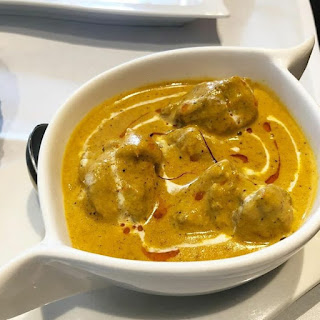Why Indian Food Is So Delicious
When I die, bury me inside a vat of saag paneer. Indian food is categorically delicious: its flavors are complex, oscillating between sweet, savory, and spicy; its textures meld creamy sauces with doughy breads and tender meat and vegetables to make the slop of dreams. It's a divine synthesis that is aromatic and sophisticated without being bougie. Hell, you can get a better-than-decent plate of it for nary more than the cost of a deli sandwich.
But what is it that makes Indian food so endlessly rich and tasty? Scientists were wondering, too, and recently performed an analysis of 2,500 recipes to find out, as first observed in the Washington Post.
Researchers Anupam Jaina, Rakhi N Kb, and Ganesh Bagler from the Indian Institute for Technology in Jodhpur ran a fine-tooth comb through TarlaDalal.com—a recipe database of more than 17,000 dishes that self-identifies as "India's #1 food site"—in attempts to decode the magic of your chicken tikka masala or aloo gobi. Sure, there are commonalities in seasoning that run through Indian cuisine as a whole, but just how varied are they?
The answer is more complicated than you might expect.
While many Western cuisines attempt to pair ingredients that share "flavor compounds"—the minute timbres that indicate something like types of sweetness or sourness or spiciness—Indian food's signature is that it combines ingredients that don't share these qualities at all.
How to study food pairing in recipes?
"We study food pairing in recipes of Indian cuisine to show that, in contrast to positive food pairing reported in some Western cuisines, Indian cuisine has a strong signature of negative food pairing," the researchers wrote. "[The] more the extent of flavor-sharing between any two ingredients, [the] lesser their co-occurrence."
For example, if you find cayenne in an Indian dish, you're unlikely to find another ingredient that shares the same compounds—though you may find other spices that have complementary, but not identical, attributes. This is true across the eight different types of sub-cuisines studied, from Bengali to Punjabi to South Indian.
A total of 194 unique ingredients were identified in the recipes, and subdivided into 15 categories: spices, seeds, herbs, meats, etc. But—rather unsurprisingly—the spices, and their methods of pairing and combination, emerged as the character-defining attributes of Indian cuisine.
That like flavors should be combined for better dishes—an unspoken but popular hypothesis stipulated by recipe-building in North American, Western European, and Latin American cultures—is an idea essentially reversed in Indian cuisine. In the words of the study, "Each of the spices is uniquely placed in its recipe to shape the flavor-sharing pattern with [the] rest of the ingredients, and is sensitive to replacement even with other spices."
In other words, each spice serves a very specific role in the dish it inhabits, from the warm sweetness of ginger to the slight bitterness of tamarind to the zingy freshness of cilantro. And it is the combination of many of these components—a typical Indian dish can incorporate a dozen different herbs and spices—that creates the flavor fingerprint that we've come to associate with a good plate of chana masala.
So while instincts may say to pile sweet on sweet or hot 'n' spicy on even more hot 'n' spicy, keep in mind that opposites sometimes attract with delicious results.
Saffron indian grill buffet has been serving the vast rich flavours from past many years. To get the essence & flavours of North and South India. Make a reservation today!



Comments
Post a Comment